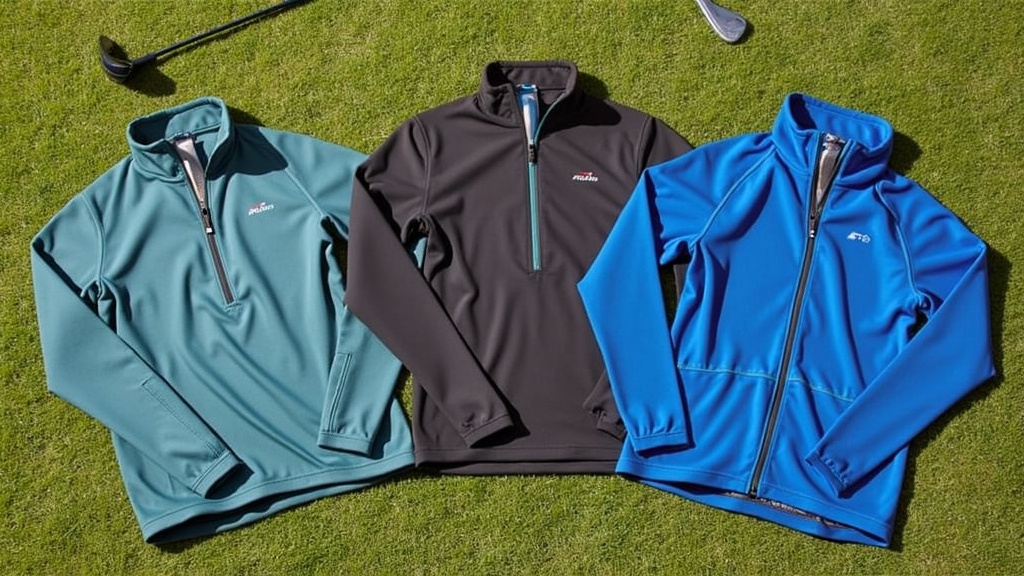If you play golf in cooler weather, you know that staying warm without turning into the Michelin Man is a real trick. Layers help keep the chill out, but the wrong combo can restrict your swing or leave you sweaty and uncomfortable. Over years of hacking my way through frosty fairways and biting winds, I’ve sorted out some layering tips that make a huge difference on the course. Here’s what actually works if you want to stay cozy and keep your swing smooth.

Why Layering Matters for Golf
If you’ve ever tried playing golf in bulky gear or with a jacket that gets caught mid-swing, you already know why layering is a big deal. Golf needs mobility and great feel, but cold air and wind can zap your energy and focus. Smart layering adds warmth without stiffness, so each shot feels as natural as possible. It’s also key because weather conditions change fast. Sunny tee times can turn into gusty afternoons, especially during shoulder seasons.
Most golfers see layering as just adding more clothes, but it’s really about picking the right types of fabrics and stacking them for comfort, flexibility, and temperature control. The golf apparel market is full of options from basic cotton to high tech synthetics, and a little knowledge on what works goes a long way toward staying warm and free moving.
How to Build a Golf Layering System
I like to break down a golf outfit into three main layers: the base, the midlayer, and the outer layer. Each plays a specific role, and getting them right makes a real difference on a chilly morning or breezy back nine.
- Base Layer: Sits closest to your skin, wicks sweat and moisture.
- Midlayer: Insulates and keeps your core temperature steady.
- Outer Layer: Shields against wind and rain while letting you move freely.
Choosing a Golf Base Layer
The base layer is all about keeping dry. Cotton can get damp and clingy, which gets cold fast, so I nearly always reach for a synthetic or merino wool base. These fabrics pull moisture away from your skin and dry quickly. This means you don’t end up feeling wet and chilly even if you work up a sweat walking the course. In the last few years, brands have started mixing in odor resistant treatments and stretch fibers, making these pieces even more comfortable for active rounds.
- Merino wool is my favorite for late fall and winter because it’s naturally warm and doesn’t get stinky as fast as synthetic fabrics. Look for lightweight or midweight options depending on the chill.
- Performance synthetics like polyester blends are lighter and usually more budget friendly. They offer good stretch and dry super fast, which is nice if you tend to sweat even in the cold.
Heavier compression shirts, popular for some runners or athletes, rarely work well for golfers. They can restrict movement and feel tight by the 18th hole. Go for a regular or slightly fitted style instead of a true compression fit. The base layer should fit close to your body, but never feel tight or hard to move in.
Midlayers: Insulation Without Bulk
Your midlayer is the real workhorse for warmth. Fleece pullovers, lightweight quarter zip tops, or wool blend sweaters all do the job. The key here is finding something that fits comfortably over your base layer, keeps you toasty, and still lets you complete a full swing without resistance.
- Microfleece or grid fleece is super warm for its weight and doesn’t trap as much air as old school fleece, so it won’t bunch up under other layers.
- Lightweight golf sweaters, especially ones made with blends of wool and synthetic, are comfortable, breathable, and look sharp both on and off the course.
Avoid heavy, chunky knits or thick sweatshirts. They might feel warm at first but can get soggy fast if you start to sweat, and you’ll notice them getting in the way of your backswing. Many midlayer pieces come with zip necks for easy venting if you heat up quickly.
Picking the Right Outer Layer
The outer layer is your first defense against wind, light rain, or fog. Here, something lightweight, wind resistant, and a little stretchy is super useful. Many golf specific jackets are designed with motion friendly panels, quiet zippers, and subtle mesh vents. These features help with both comfort and performance.
- Windbreakers made for golf usually strike the best balance of stretch and weather resistance. I look for ones with zippered vents or laser cut holes under the arms to avoid overheating.
- Water repellent shells are important if you might run into light rain or heavy mist, but feel free to skip full-blown rain suits unless you’re absolutely determined to play in a downpour.
Puffier jackets or coats rarely work well, even if you’re really cold. It’s always easier to add an extra midlayer under a shell than to play in something bulky on top. If you need extra warmth, consider a thin insulated vest layered between your mid and outer layers; the vest adds core warmth while leaving your arms free.
Smart Fabric Choices
Golf clothing tech isn’t hype. Wearable tech fabrics have gotten pretty advanced over the years. Some fabrics are brushed on the inside for extra comfort, wick moisture, and even block UV rays. Breathability is equally important. Look for mesh lined, vented, or breathable membrane in descriptions—these features stop you from overheating when the sun pops back out mid-round.
If you often tee off early, look for layers with a bit of reflective detail for visibility. Handy for those first few holes at sunrise. Thumb holes on sleeves and adjustable cuffs are small design features that I appreciate for locking out drafts and keeping your wrists warm in cool air. Another idea is picking outerwear with a drop hem in the back, so your lower back stays covered during your swing.
Layering Strategies That Actually Work
It took me a while to find the right balance between warmth and mobility. Here are a few practical layering strategies that work for regular golfers:
- Dress for the middle holes, not just the first tee. It’s tempting to pile on the warmth for that first cold blast, but you’ll heat up once you get moving. Layer a thin midlayer you can easily remove or unzip if you warm up.
- Use a vest for flexible warmth. An insulated or wind blocking vest is awesome for keeping your core warm while still letting your arms swing freely—a great combo for chilly but not frigid mornings.
- Don’t overdo it on socks and hats. Thick socks can make your shoes tight, which ends up colder, and double hats can just make you sweaty and itchy. Try merino or synthetic options for both: light, warm, and less clammy as you play.
If in doubt, bring a backup layer in your golf bag; many jackets roll up tiny, and you can always shed a layer or two if you get too warm on the back nine.
Challenges and Solutions With Layering
- Bunching or shifting layers: Pick smooth finish, fitted base and midlayers that slide easily under your jacket. Avoid bulky seams that can dig in with a golf bag strap and always double check the fit by doing a few practice swings at home.
- Too much heat: If the sun comes out and you overheat, you want something you can quickly unzip, peel off, or stuff in your bag. Jackets that pack down small are really handy, especially for travel or unpredictable weather.
- Mobility issues: Make sure to take a few practice swings in your full setup before heading out. If something feels tight or pulls at the shoulders, it’s worth swapping out before the first tee shot.
Weather Considerations for Golf Layering
Weather is unpredictable, especially during spring and fall. Wind resistant outerwear is non negotiable if you play in breezy places. For drizzly climates, add a lightweight water resistant shell into your bag just in case. For cold but dry days, focus on midlayers with high warmth to weight ratios instead of bulking up with heavier jackets.
Extra Tricks for Staying Warm
- Hand warmers: Stash a couple in your pockets or golf bag. They’re tiny and keep chilly hands loose and relaxed.
- Neck gaiters or lightweight snoods: These are easy to pull up or down and block cold gusts without the drama of a full scarf. They’re especially useful if you’re sensitive to wind on the back nine or if your usual collar leaves your neck exposed.
- Swap gloves between holes: Carry an extra pair and swap them out if they get damp. Dry hands keep your grip firm and comfortable no matter the temperature.
Common Questions About Golf Layering
Here are answers to some of the questions I hear most often about layering for golf in cold conditions.
What material should I avoid as a base layer for golf?
Cotton is best left out. It soaks up sweat and dries slowly, making you colder the longer you’re outside.
Is a full rain suit needed for most rounds?
Unless you’re playing in heavy rain, a good water resistant shell with the right base and midlayers beneath is usually enough and lets you move better.
How do I prevent layers from restricting my swing?
Choose each layer for stretch and fit. Many golf brands test their gear with real swings so check reviews or try swinging in the store or at home before buying. Always make sure the shoulders and arms move freely in all your layers.
My Recommended Layering Gear for Golf
Sifting through all the gear out there can feel overwhelming. Here are some layer types and items I’ve put into play:
- Base: Lightweight merino short or longsleeve tees, athletic polyester tops.
- Mid: Quarter zip microfleece pullovers, synthetic blend vests, lightweight golf sweaters.
- Outer: Stretchy wind jackets, packable water resistant shells, hybrid vests with wind panels.
Mix and match depending on where you play and your cold tolerance. Golf specialty shops and major athletic brands both offer good options. Remember to check the fit and see how you move in everything. Swinging freely is just as important as warmth; don’t compromise one for the other.
Picking the right layers can make cold weather rounds totally enjoyable. Staying dry, comfortable, and able to move smoothly keeps you focused on your game, not on the forecast. With the right layering strategy, you’ll be set to play your best regardless of the temperature outside.
